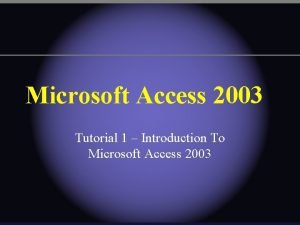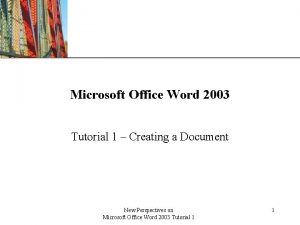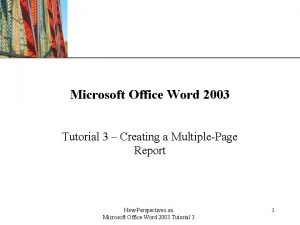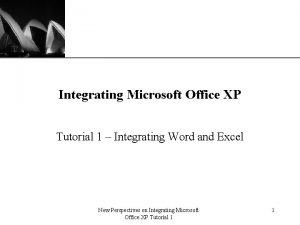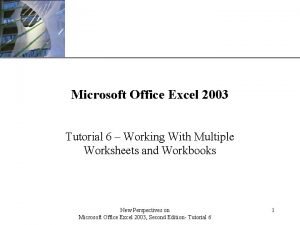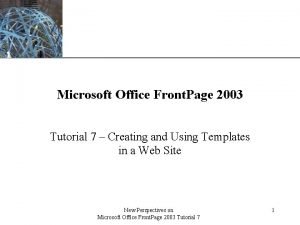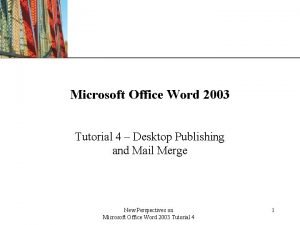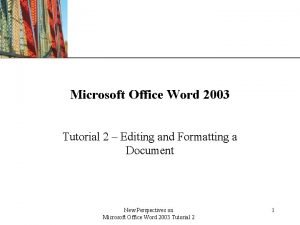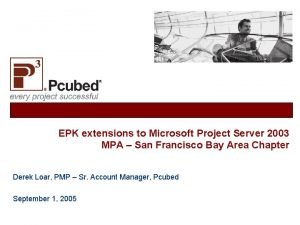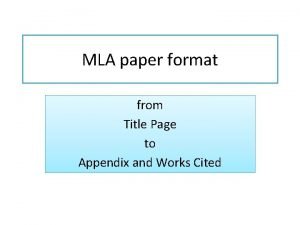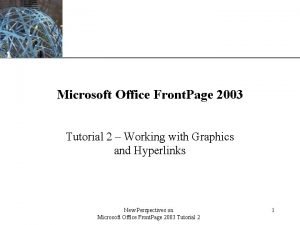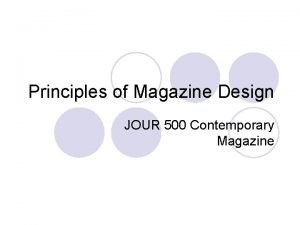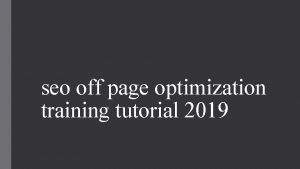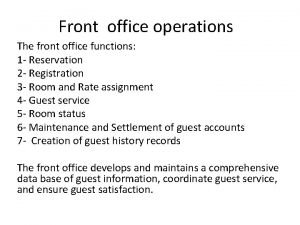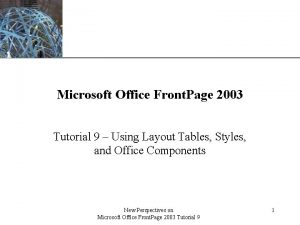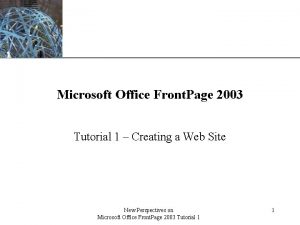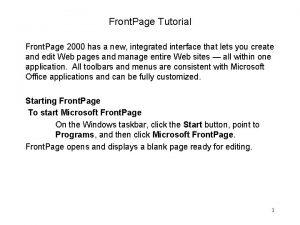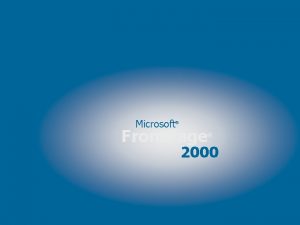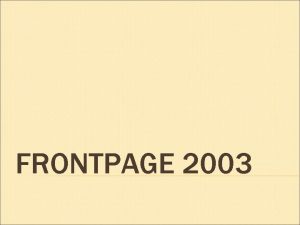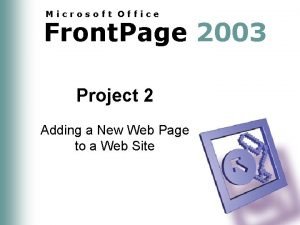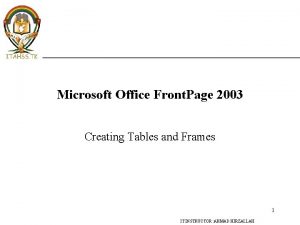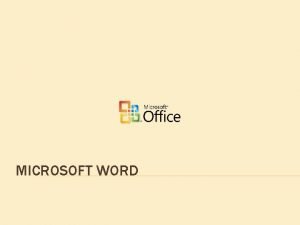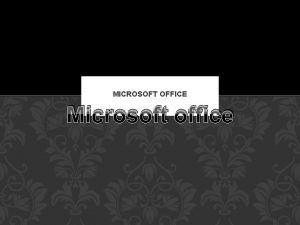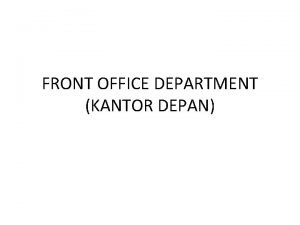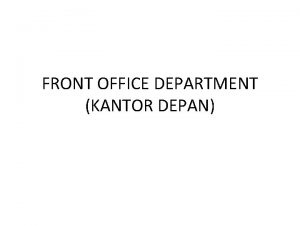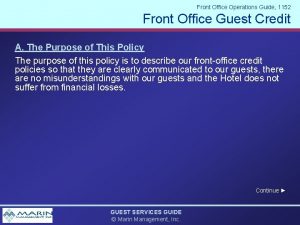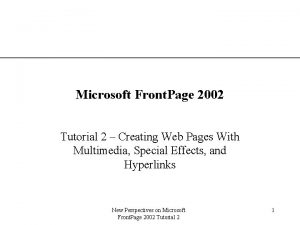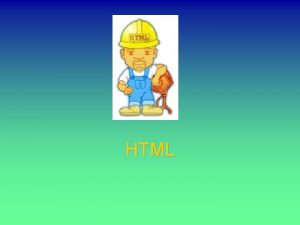XP Microsoft Office Front Page 2003 Tutorial 4

































- Slides: 33

XP Microsoft Office Front. Page 2003 Tutorial 4 – Using Shared Borders and Themes New Perspectives on Microsoft Office Front. Page 2003 Tutorial 4 1

XP Shared Borders and Link Bars • The home page in your Web site is called the parent page. Pages below the home page are child pages. • A link bar component is a link bar that Front. Page maintains and updates automatically. • A shared border is an area of your page that contains content and appears in every page that uses it. New Perspectives on Microsoft Office Front. Page 2003 Tutorial 4 2

Adding a Page to the Navigation XP Structure New Perspectives on Microsoft Office Front. Page 2003 Tutorial 4 3

XP Renaming a Page’s Title in Navigation View • Right-click the page icon in the navigation structure to open the shortcut menu, and then click Rename. • Type the new page title, and then press the Enter key. New Perspectives on Microsoft Office Front. Page 2003 Tutorial 4 4

Creating Shared Borders in a Web Site XP • If necessary, position pages in the navigation structure. • Click Format on the menu bar, and then click Shared Borders. • Select the option button for applying the shared border to all or selected pages, select the shared border(s) to add, select the option to include navigation buttons if desired, and then click the OK button. New Perspectives on Microsoft Office Front. Page 2003 Tutorial 4 5

Shared Borders Dialog Box New Perspectives on Microsoft Office Front. Page 2003 Tutorial 4 XP 6

The Link Bar New Perspectives on Microsoft Office Front. Page 2003 Tutorial 4 XP 7

XP Deleting a Page in Navigation View • Right-click the page icon in the navigation structure that you want to delete to select the page and open the shortcut menu. • Click Delete to open the Delete Page dialog box. • Click the Remove this page from the navigation structure option button to delete the page from only the navigation structure, or click the Delete this page from the Web option button to delete the page from the navigation structure and the Web site. • Click the OK button. New Perspectives on Microsoft Office Front. Page 2003 Tutorial 4 8

Page Removed from Link Bar Component New Perspectives on Microsoft Office Front. Page 2003 Tutorial 4 XP 9

Creating a New Page in Navigation View XP • Right-click the page icon that will be the parent for the new page to select it and to open the shortcut menu. • Point to New on the shortcut menu, and then click Page. • Right-click the page icon for the new page to open the shortcut menu, click Rename, enter the page’s title, and then press the Enter key. Front. Page will create the Web page using the title you entered. To change the default filename, change to Folders view, click the filename of the new page to select it, type a new filename, and then press the Enter key. New Perspectives on Microsoft Office Front. Page 2003 Tutorial 4 10

Disabling Shared Borders for a Single Web Page XP • Open the page in Design view. • Click Format on the menu bar, and then click Shared Borders to open that dialog box. • Click the Current page option button to select it. • Click the Top, Left, Right, and Bottom check boxes, as necessary, to turn off the appropriate • shared borders. • Click the OK button. New Perspectives on Microsoft Office Front. Page 2003 Tutorial 4 11

XP Creating a Page Banner • If necessary, position the page in the site’s navigation structure. • Click the location in the Web page where you want the banner to appear. • Click Insert on the menu bar, and then click Page Banner. • Select the Picture or Text option button to indicate the type of banner to create. • Edit the text in the Page banner text box as necessary. • Click the OK button. New Perspectives on Microsoft Office Front. Page 2003 Tutorial 4 12

XP Page Banner Properties Dialog Box New Perspectives on Microsoft Office Front. Page 2003 Tutorial 4 13

Creating a Custom Link Bar in Navigation View XP • Change to Navigation view, and, if necessary, display the Folder List. • Make sure that no page icon is selected in the navigation structure, and then click the New Custom Link Bar button on the Contents pane. • Right-click the New Link Bar page icon to select it and to open the shortcut menu, type a name for the custom link bar, and then press the Enter key. • Drag the filename of the first page you want to include in the custom link bar from the Folder List and position it in the custom link bar navigation structure. Repeat this step to include the appropriate pages in the custom link bar. New Perspectives on Microsoft Office Front. Page 2003 Tutorial 4 14

XP Creating a Custom Link Bar in Navigation View • Open the page in which to display the custom link bar, position the insertion point where you want to insert it, click Insert on the menu bar, and then click Navigation. Select the Bar with custom links option in the Choose a bar type list, click the Next button, choose the desired bar style, click the Next button, choose the desired orientation, and then click the Finish button. • In the Link Bar Properties dialog box, click the Choose existing list arrow and select the custom link bar to use in the page. (If your Web site has only one custom link bar, then the one you created will be selected automatically. ) • Use the Add link, Remove link, and Modify link buttons to add new links and delete or modify existing links. To move a link’s position in the link bar, select it and then click the Move up or Move down buttons to position it in the desired location. • Click the OK button. New Perspectives on Microsoft Office Front. Page 2003 Tutorial 4 15

Link Bar Properties Dialog Box New Perspectives on Microsoft Office Front. Page 2003 Tutorial 4 XP 16

Applying a Theme to a Web Site XP • A theme is a collection of design elements—bullets, backgrounds, table borders, fonts, and pictures—that you can apply to an entire Web site or to only one or more specific Web pages. • A Web site with a theme applied to it has a consistent appearance because the formatting applied by theme is the same in every page. • Everything in the page is professionally designed to fit together. New Perspectives on Microsoft Office Front. Page 2003 Tutorial 4 17

Applying a Theme to a Web Site XP • In Design view, Folders view, or Navigation view, click Format on the menu bar, and then click Theme. • Scroll themes in the Theme task pane to find one of interest. If a page is open in Design view, clicking theme temporarily applies theme to the page. • If desired, select the options for Vivid colors, Active graphics, and a Background picture in the Theme task pane. • When you locate an appropriate theme, click the list arrow that appears when you point to the desired theme. To apply theme to the entire Web site, click Apply as default theme in the menu. To apply theme to the currently selected page(s) in Folders, Navigation, or Design view, click Apply to selected page(s) in the menu. • Click the Yes button to apply theme. New Perspectives on Microsoft Office Front. Page 2003 Tutorial 4 18

Web Page with Theme Applied New Perspectives on Microsoft Office Front. Page 2003 Tutorial 4 XP 19

Customizing an Existing Theme XP • Click Format on the menu bar, and then click Theme to open the Theme task pane. • Point to theme that you want to customize, and then click the list arrow that appears. • Click Customize in the menu that opens. The Customize Theme dialog box opens. • Click the Colors button to customize the colors used in theme, click the Graphics button to customize pictures and other graphic elements used in theme, or click the Text button to customize the fonts and font styles of text elements used in theme. • When you have finished customizing the desired theme elements, click the Save button, type a name for the custom theme, click the OK button, and then click the Yes button. New Perspectives on Microsoft Office Front. Page 2003 Tutorial 4 20

Customize Theme Dialog Box New Perspectives on Microsoft Office Front. Page 2003 Tutorial 4 XP 21

XP Deleting a Custom Theme from your Hard Drive • If necessary, close all open Web sites in Front. Page. • Click Format on the menu bar, and then click Theme to open the Theme task pane. • Locate and click the custom theme in the All available themes section that you want to delete. • Click Delete in the menu that opens. • Click the Yes button in the message box that opens. New Perspectives on Microsoft Office Front. Page 2003 Tutorial 4 22

Creating a New Theme XP • In the Theme task pane, click the Create new theme link. • Use the Colors, Graphics, and Text buttons to apply the desired formatting to different elements of theme. • Click the Save button and provide a name for the new theme, and then click the OK button. • Click the OK button to close the Customize Theme dialog box. New Perspectives on Microsoft Office Front. Page 2003 Tutorial 4 23

Customize Theme Dialog Box New Perspectives on Microsoft Office Front. Page 2003 Tutorial 4 XP 24

Custom Theme Applied New Perspectives on Microsoft Office Front. Page 2003 Tutorial 4 XP 25

XP Removing a Theme From a Page or Web Site • To remove a theme from a Web page, open the page in Design view, open the Theme task pane, point to the No theme in the All available themes section, click the list arrow that appears, and then click Apply to selected page(s). • To remove a theme from a Web site, open the Theme task pane, point to the No theme in the All available themes section, click the list arrow that appears, click Apply as default theme, and then click the Yes button. New Perspectives on Microsoft Office Front. Page 2003 Tutorial 4 26

XP Creating a Photo Gallery in a Page • A photo gallery lets you add pictures with captions and descriptions to your Web pages. • Click the desired location in which to add the photo gallery. • Click Insert on the menu bar, point to Picture, and then click New Photo Gallery. • Click the Add button, click Pictures from Files, and then browse to and double-click a picture file to include in the photo gallery. • Click in the Caption text box, and then type the photo’s caption. • Press the Tab key, and then type the photo’s description. New Perspectives on Microsoft Office Front. Page 2003 Tutorial 4 27

XP Creating a Photo Gallery in a Page • If necessary, click the Override and use custom font formatting option button to enable the options to format the caption and description using the Formatting toolbar options in the dialog box. • Add more photos and their captions and descriptions to the photo gallery as necessary. • Click the Layout tab, and then select a layout for the photo gallery. • When you are finished adding photos, click the OK button. New Perspectives on Microsoft Office Front. Page 2003 Tutorial 4 28

XP Photo Gallery Properties Dialog Box New Perspectives on Microsoft Office Front. Page 2003 Tutorial 4 29

Web Page with Photo Gallery New Perspectives on Microsoft Office Front. Page 2003 Tutorial 4 XP 30

XP Drawings, Auto. Shapes, and Word. Art • A drawing is a canvas object that contains other objects, such as text boxes and arrows. • An Auto. Shape is a predesigned shape, such as an arrow, bracket, square, circle, banner, star, or callout. • Word. Art is a text object to which you can apply a font, font size, and special effects. New Perspectives on Microsoft Office Front. Page 2003 Tutorial 4 31

XP Creating a Word. Art Object in a Page • If necessary, select the existing text that you will format as a Word. Art object. • Click Insert on the menu bar, point to Picture, and then click Word. Art. The Word. Art Gallery dialog box opens. • Click the Word. Art style to use for your text, and then click the OK button. The Edit Word. Art Text dialog box opens. • Select the font, font size, and font style for your text. If necessary, type or edit the text for the Word. Art object in the Text text box. • Click the OK button. • Use the Word. Art toolbar to change the color, shape, letter height, direction, alignment, or character spacing of the Word. Art object, if desired. • Use the sizing handles on the Word. Art object to resize the Word. Art object, if desired. New Perspectives on Microsoft Office Front. Page 2003 Tutorial 4 32

XP Web Page with Word Art Added New Perspectives on Microsoft Office Front. Page 2003 Tutorial 4 33
 Access 2003 tutorial
Access 2003 tutorial Microsoft word 2003 tutorial
Microsoft word 2003 tutorial Word 2003 tutorial
Word 2003 tutorial School magazine cover
School magazine cover Microsoft front page
Microsoft front page Ms project 2010 tutorial
Ms project 2010 tutorial Microsoft project 2010 tutorial
Microsoft project 2010 tutorial Microsoft office xp tutorial
Microsoft office xp tutorial Excel 2003 tutorial
Excel 2003 tutorial Frontpage 2003 tutorial
Frontpage 2003 tutorial Tutorial word 2003
Tutorial word 2003 Ms word 2003 tutorial
Ms word 2003 tutorial Microsoft windows storage server 2003
Microsoft windows storage server 2003 Microsoft project 2003
Microsoft project 2003 Microsoft project server demo
Microsoft project server demo Ms project server 2003
Ms project server 2003 Example of author heading format
Example of author heading format Appendix in a paper
Appendix in a paper Action research front page
Action research front page It the most prominent text element after the nameplate.
It the most prominent text element after the nameplate. Index front page
Index front page Anatomy of a news article
Anatomy of a news article Magazine cover page
Magazine cover page Ignou project synopsis front page
Ignou project synopsis front page Dead front vs live front transformer
Dead front vs live front transformer Diagram of a warm front
Diagram of a warm front Seo off page optimization tutorial
Seo off page optimization tutorial Tutorial 3 designing a page layout
Tutorial 3 designing a page layout Https://forms.office.c
Https://forms.office.c Master folio
Master folio Organizational chart of front office department
Organizational chart of front office department Front office accounting
Front office accounting Duties and responsibilities of front office personnel
Duties and responsibilities of front office personnel Room spoilage front office
Room spoilage front office
